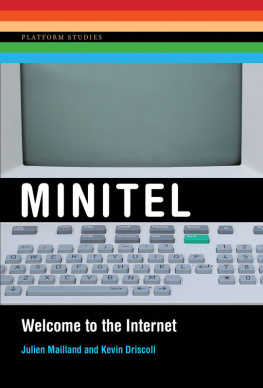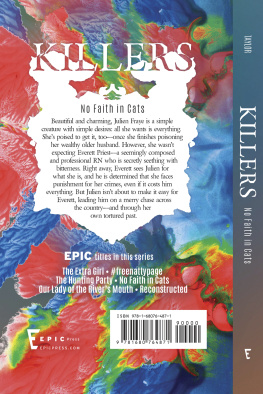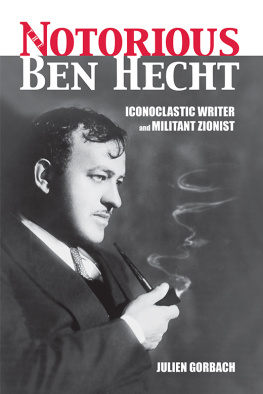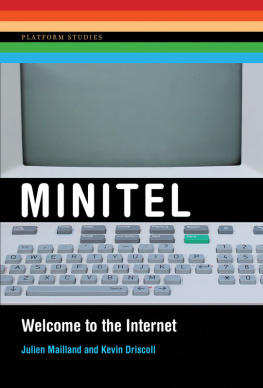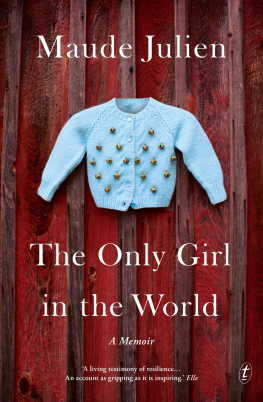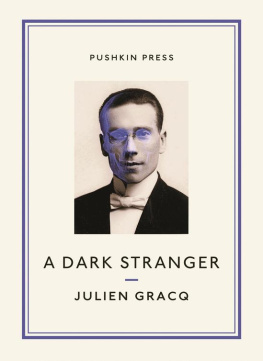Julien Mailland - Minitel: Welcome to the Internet
Here you can read online Julien Mailland - Minitel: Welcome to the Internet full text of the book (entire story) in english for free. Download pdf and epub, get meaning, cover and reviews about this ebook. year: 2017, publisher: The MIT Press, genre: Politics. Description of the work, (preface) as well as reviews are available. Best literature library LitArk.com created for fans of good reading and offers a wide selection of genres:
Romance novel
Science fiction
Adventure
Detective
Science
History
Home and family
Prose
Art
Politics
Computer
Non-fiction
Religion
Business
Children
Humor
Choose a favorite category and find really read worthwhile books. Enjoy immersion in the world of imagination, feel the emotions of the characters or learn something new for yourself, make an fascinating discovery.
- Book:Minitel: Welcome to the Internet
- Author:
- Publisher:The MIT Press
- Genre:
- Year:2017
- Rating:3 / 5
- Favourites:Add to favourites
- Your mark:
- 60
- 1
- 2
- 3
- 4
- 5
Minitel: Welcome to the Internet: summary, description and annotation
We offer to read an annotation, description, summary or preface (depends on what the author of the book "Minitel: Welcome to the Internet" wrote himself). If you haven't found the necessary information about the book — write in the comments, we will try to find it.
Minitel: Welcome to the Internet — read online for free the complete book (whole text) full work
Below is the text of the book, divided by pages. System saving the place of the last page read, allows you to conveniently read the book "Minitel: Welcome to the Internet" online for free, without having to search again every time where you left off. Put a bookmark, and you can go to the page where you finished reading at any time.
Font size:
Interval:
Bookmark:

Platform Studies
Nick Montfort and Ian Bogost, editors
Racing the Beam: The Atari Video Computer System, Nick Montfort and Ian Bogost, 2009
Codename Revolution: The Nintendo Wii Platform, Steven E. Jones and George K. Thiruvathukal, 2012
The Future Was Here: The Commodore Amiga, Jimmy Maher, 2012
Flash: Building the Interactive Web, Anastasia Salter and John Murray, 2014
I AM ERROR: The Famicom / Nintendo Entertainment System Platform, Nathan Altice, 2015
Peripheral Vision: Bell Labs, the S-C 4020, and the Origins of Computer Art, Zabet Patterson, 2015
Now the Chips Are Down: The BBC Micro, Alison Gazzard, 2016
Minitel: Welcome to the Internet, Julien Mailland and Kevin Driscoll, 2017
Julien Mailland and Kevin Driscoll
The MIT Press
Cambridge, Massachusetts
London, England
2017 Massachusetts Institute of Technology
All rights reserved. No part of this book may be reproduced in any form by any electronic or mechanical means (including photocopying, recording, or information storage and retrieval) without permission in writing from the publisher.
This book was set in ITC Stone Serif Std by Toppan Best-set Premedia Limited. Printed and bound in the United States of America.
Library of Congress Cataloging-in-Publication Data
Names: Mailland, Julien, author. | Driscoll, Kevin, author.
Title: Minitel : welcome to the Internet / Julien Mailland and Kevin Driscoll.
Description: Cambridge, MA : The MIT Press, 2017. | Series: Platform studies
| Includes bibliographical references and index.
Identifiers: LCCN 2016042225 | ISBN 9780262036221 (hardcover : alk. paper)
eISBN 9780262340199
Subjects: LCSH: Minitel (Videotex system) | Technology and
state--France--History--20th century. | Technology and
state--France--History--21st century.
Classification: LCC QA76.57.M55 M35 2017 | DDC 384.3/3--dc23 LC record available at https://lccn.loc.gov/2016042225
ePub Version 1.0
How can someone create a breakthrough game for a mobile phone or a compelling work of art for an immersive 3D environment without understanding that the mobile phone and the 3D environment are different sorts of computing platforms? The best artists, writers, programmers, and designers are well aware of how certain platforms facilitate certain types of computational expression and innovation. Likewise, computer science and engineering have long considered how underlying computing systems can be analyzed and improved. As important as scientific and engineering approaches are, and as significant as work by creative artists has been, there is also much to be learned from the sustained, intensive, humanistic study of digital media. We believe it is time for humanists to seriously consider the lowest level of computing systems and their relationship to culture and creativity.
The Platform Studies series has been established to promote the investigation of underlying computing systems and of how they enable, constrain, shape, and support the creative work that is done on them. The series investigates the foundations of digital mediathe computing systems, both hardware and software, that developers and users depend upon for artistic, literary, and gaming development. Books in the series will certainly vary in their approaches, but they will all share certain features:
- a focus on a single platform or a closely related family of platforms
- technical rigor and in-depth investigation of how computing technologies work
- an awareness of and a discussion of how computing platforms exist in a context of culture and society, being developed on the basis of cultural concepts and then contributing to culture in a variety of waysfor instance, by affecting how people perceive computing.
Minitel was brought to life through the ingenuity of countless engineers, entrepreneurs, administrators, and enthusiasts. While Internet folklore tends to celebrate small groups of computer wizards hacking away in basements and garages, Minitel thrived at the forefront of French popular culture. During the 1980s and 1990s, Minitel was on the street, in the cinema, on the radio, and in the news. People from all over France experimented with the new mediummen and women, young and old, urbanites and country dwellers, rich and poor, gay and straight. That Minitel continues to provoke our thinking about technology, policy, and culture is a tribute to the creativity and curiosity of its diverse users.
Just as Minitel was produced by a multitude, many different people assisted in the preparation of this book. We would like to thank the staff at Orange/Direction de la Gestion et de la Conservation de lInformation, the Conseil dtat, and the Archives Nationales whose help in locating and scanning materials was crucialin particular, Emmanuelle Flament-Guelfucci, Pierre Philippi, and Irmine Vieira as well as the community of researchers and Orange employees and former employees in Brittany, Paris, and San Francisco who provided us with access, support, feedback, and unbridled enthusiasm about the ongoing relevance of Minitel: Isabelle Astic, Patrice Battiston, Yochai Benkler, Jean-Luc Beraudo De Pralormo, John Coate, Daniel Hannaby, Bernard Louvel, Jean-Paul Maury, Georges Nahon, Camille Paloque-Berges, Bernard Peuto, Monroe Price, Valrie Schafer, Grard Thry, Benjamin Thierry, and Marc Weber. In addition to archival research, this book depends on several firsthand accounts, and we are grateful to those individuals who agreed to sit for interviews: Michel Baujard, Jean-Luc Beraudo De Pralormo, Laurent Chemla, John Coate, Daniel Hannaby, Jean-Baptiste Ingold, Michel Landaret, Bernard Louvel, Allan Lundell, Jean-Marc Manach, Bernard Marti, Jean-Paul Maury, Georges Nahon, Dusty Parks, Jean-Eudes Quefflec, Christian Quest, Grard Thry, and LaRoy Tymes.
A big shout-out goes to todays Minitel enthusiasts whose hacks, pranks, and tributes provided us with inspiration and insight during the preparation of this book. We are especially grateful to those minitelistes who document their explorations for other to follow. Special thanks are due to Frdric Cambus, whose archives of Minitel and French bulletin board systems materials were invaluable during the research process.
We would like to thank Ian Bogost and Nick Montfort, editors of the Platform Studies series, for their early enthusiasm and ongoing support for the project, and Doug Sery, acquisitions editor at the MIT Press, Virginia Crossman, assistant editor at the MIT Press, and Susan Clark, catalog manager at the MIT Press, for their stewardship. Finally, we would like to thank the anonymous reviewers for their thoughtful feedback.
Julien would like to thank his colleagues at Indiana University, especially Barb Cherry, Annie Lang, Matt Pierce, Harmeet Sawhney, and David Waterman for always lending a keen Minitel ear, Vicki Nash and the participants in the 2011 Oxford Internet Institute Summer Doctoral Program, and his committee members at the University of Southern California Annenberg School for Communication and Journalism: Jonathan Aronson, Franois Bar, Steve Lamy, Daniel Lynch, and Philip Seib.
Kevin wishes to thank his colleagues at Microsoft Research New England for their guidance and support, particularly Andrea Alarcon, Nancy Baym, Christian Borgs, Sarah Brayne, Jennifer Chayes, Tarleton Gillespie, Sharon Gillett, Mary Gray, Rebecca Hoffman, Jessa Lingel, Lana Swartz, and all of the wonderful interns and visitors who passed through the Social Media Collective. He is also indebted to Henry Jenkins for many years of mentorship and inspiration. Finally, Kevin is grateful to his family, Ed, Katie, Mark, and Mary, and especially his spouse, Lana Swartz, for her wisdom, humor, and grace.
Next pageFont size:
Interval:
Bookmark:
Similar books «Minitel: Welcome to the Internet»
Look at similar books to Minitel: Welcome to the Internet. We have selected literature similar in name and meaning in the hope of providing readers with more options to find new, interesting, not yet read works.
Discussion, reviews of the book Minitel: Welcome to the Internet and just readers' own opinions. Leave your comments, write what you think about the work, its meaning or the main characters. Specify what exactly you liked and what you didn't like, and why you think so.

